2020 YAMAHA TRICITY 300 Wheel
[x] Cancel search: WheelPage 91 of 114
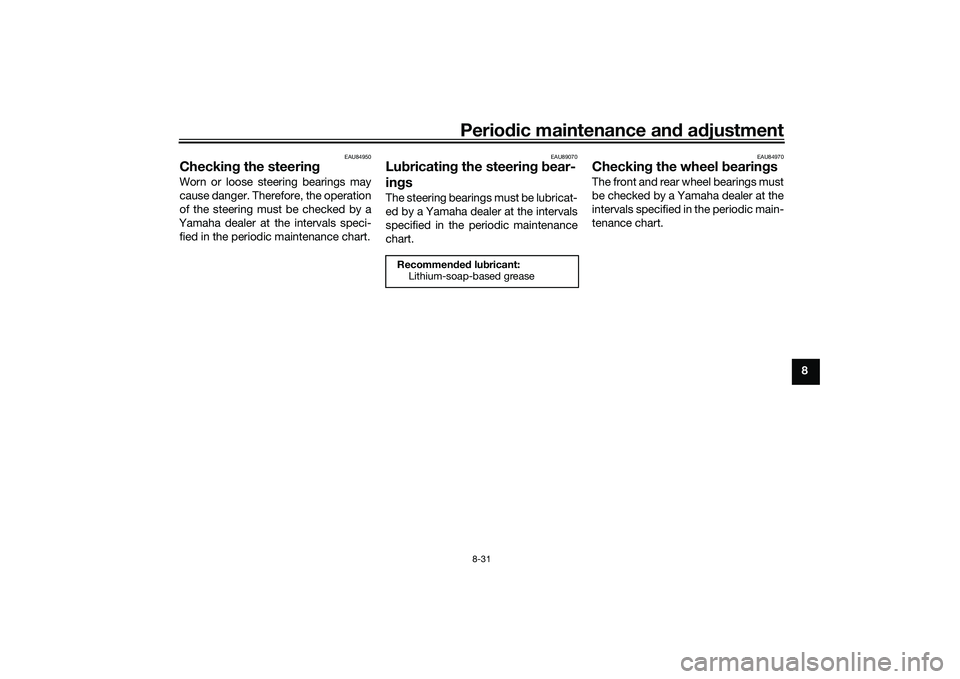
Periodic maintenance an d a djustment
8-31
8
EAU84950
Checkin g the steerin gWorn or loose steering bearings may
cause danger. Therefore, the operation
of the steering must be checked by a
Yamaha dealer at the intervals speci- fied in the periodic maintenance chart.
EAU89070
Lu bricatin g the steering b ear-
in gsThe steering bearings must be lubricat-
ed by a Yamaha dealer at the intervals
specified in the periodic maintenance
chart.
EAU84970
Checkin g the wheel bearin gsThe front and rear wheel bearings must
be checked by a Yamaha dealer at the
intervals specified in the periodic main-
tenance chart.
Recommen ded lu bricant:
Lithium-soap-based grease
UBX9E0E0.book Page 31 Monday, January 20, 2020 10:54 AM
Page 102 of 114
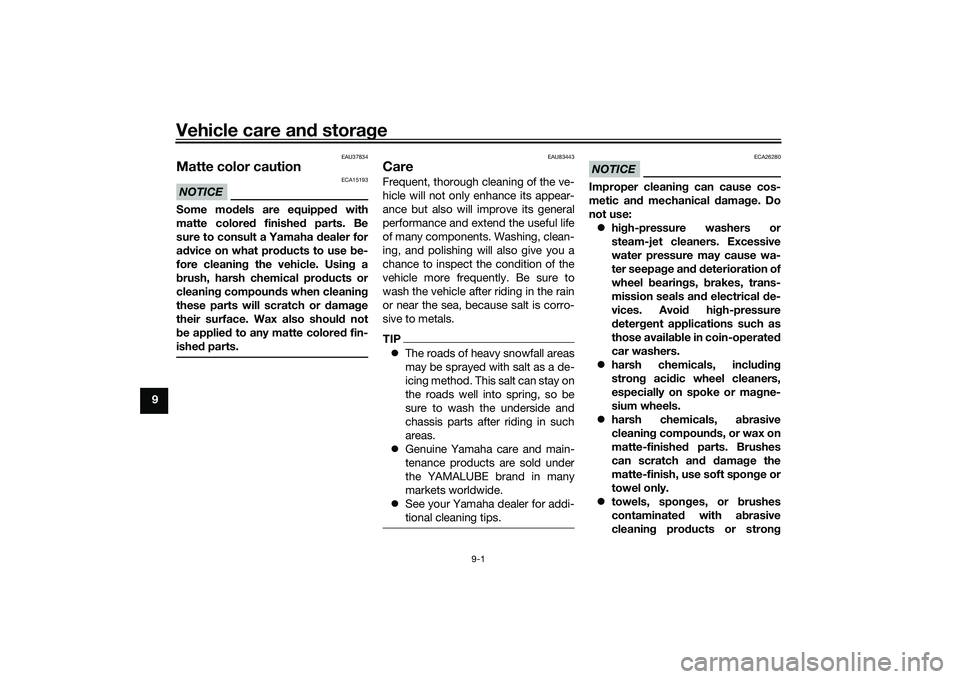
Vehicle care and stora ge
9-1
9
EAU37834
Matte color cautionNOTICE
ECA15193
Some mo dels are equipped with
matte colore d finishe d parts. Be
sure to consult a Yamaha d ealer for
a d vice on what prod ucts to use be-
fore cleanin g the vehicle. Usin g a
b rush, harsh chemical prod ucts or
cleanin g compoun ds when cleanin g
these parts will scratch or damag e
their surface. Wax also shoul d not
b e applied to any matte colore d fin-
ishe d parts.
EAU83443
CareFrequent, thorough cleaning of the ve-
hicle will not only enhance its appear-
ance but also will improve its general
performance and extend the useful life
of many components. Washing, clean-
ing, and polishing will also give you a
chance to inspect the condition of the
vehicle more frequently. Be sure to
wash the vehicle after riding in the rain
or near the sea, because salt is corro-
sive to metals.TIP The roads of heavy snowfall areas
may be sprayed with salt as a de-
icing method. This salt can stay on
the roads well into spring, so be
sure to wash the underside and
chassis parts after riding in such
areas.
Genuine Yamaha care and main-
tenance products are sold under
the YAMALUBE brand in many
markets worldwide.
See your Yamaha dealer for addi-
tional cleaning tips.
NOTICE
ECA26280
Improper cleanin g can cause cos-
metic an d mechanical damag e. Do
not use: high-pressure washers or
steam-jet cleaners. Excessive
water pressure may cause wa-
ter seepa ge an d d eterioration of
wheel bearin gs, brakes, trans-
mission seals an d electrical d e-
vices. Avoi d hi gh-pressure
d eter gent applications such as
those availa ble in coin-operate d
car washers.
harsh chemicals, inclu din g
stron g aci dic wheel cleaners,
especially on spoke or ma gne-
sium wheels.
harsh chemicals, ab rasive
cleanin g compoun ds, or wax on
matte-finishe d parts. Brushes
can scratch an d damag e the
matte-finish, use soft spon ge or
towel only.
towels, spon ges, or brushes
contaminated with abrasive
cleanin g prod ucts or stron g
UBX9E0E0.book Page 1 Monday, January 20, 2020 10:54 AM
Page 103 of 114
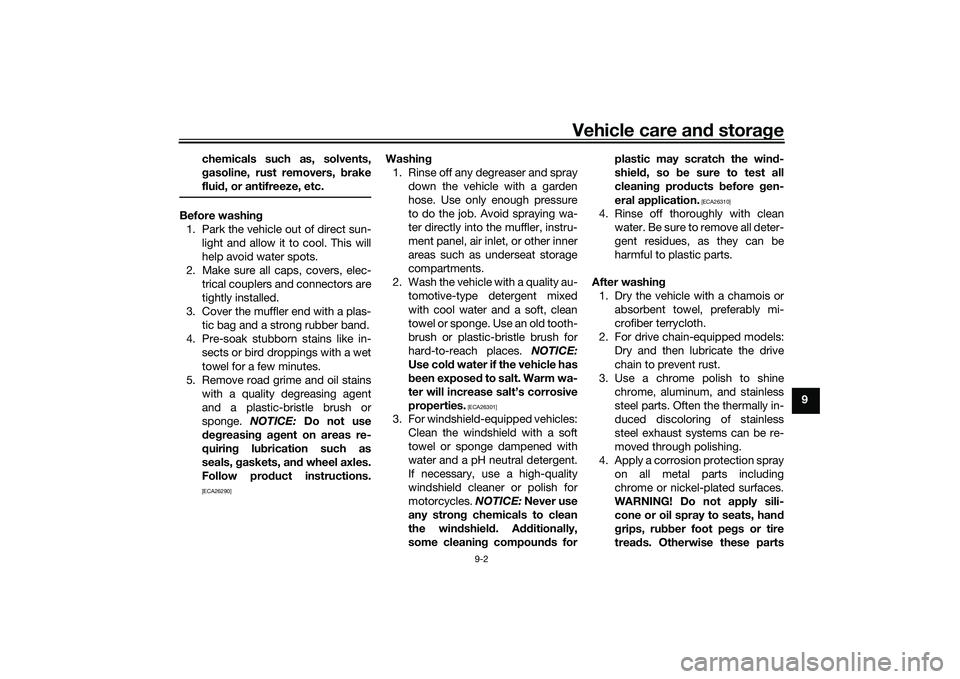
Vehicle care and stora ge
9-2
9
chemicals such as, solvents,
g
asoline, rust removers, b rake
flui d, or antifreeze, etc.
Before washin g
1. Park the vehicle out of direct sun- light and allow it to cool. This will
help avoid water spots.
2. Make sure all caps, covers, elec- trical couplers and connectors are
tightly installed.
3. Cover the muffler end with a plas- tic bag and a strong rubber band.
4. Pre-soak stubborn stains like in- sects or bird droppings with a wet
towel for a few minutes.
5. Remove road grime and oil stains with a quality degreasing agent
and a plastic-bristle brush or
sponge. NOTICE: Do not use
d eg reasin g a gent on areas re-
quirin g lu brication such as
seals, gaskets, an d wheel axles.
Follow pro duct instructions.
[ECA26290]
Washin g
1. Rinse off any degreaser and spray down the vehicle with a garden
hose. Use only enough pressure
to do the job. Avoid spraying wa-
ter directly into the muffler, instru-
ment panel, air inlet, or other inner
areas such as underseat storage
compartments.
2. Wash the vehicle with a quality au- tomotive-type detergent mixed
with cool water and a soft, clean
towel or sponge. Use an old tooth-
brush or plastic-bristle brush for
hard-to-reach places. NOTICE:
Use col d water if the vehicle has
b een exposed to salt. Warm wa-
ter will increase salt’s corrosive
properties.
[ECA26301]
3. For windshield-equipped vehicles: Clean the windshield with a soft
towel or sponge dampened with
water and a pH neutral detergent.
If necessary, use a high-quality
windshield cleaner or polish for
motorcycles. NOTICE: Never use
any stron g chemicals to clean
the wind shield. Additionally,
some cleanin g compoun ds for plastic may scratch the win
d-
shiel d, so b e sure to test all
cleanin g pro ducts before gen-
eral application.
[ECA26310]
4. Rinse off thoroughly with clean water. Be sure to remove all deter-
gent residues, as they can be
harmful to plastic parts.
After washin g
1. Dry the vehicle with a chamois or absorbent towel, preferably mi-
crofiber terrycloth.
2. For drive chain-equipped models: Dry and then lubricate the drive
chain to prevent rust.
3. Use a chrome polish to shine chrome, aluminum, and stainless
steel parts. Often the thermally in-
duced discoloring of stainless
steel exhaust systems can be re-
moved through polishing.
4. Apply a corrosion protection spray on all metal parts including
chrome or nickel-plated surfaces.
WARNING! Do not apply sili- cone or oil spray to seats, han d
g rips, ru bber foot pe gs or tire
trea ds. Otherwise these parts
UBX9E0E0.book Page 2 Monday, January 20, 2020 10:54 AM
Page 105 of 114
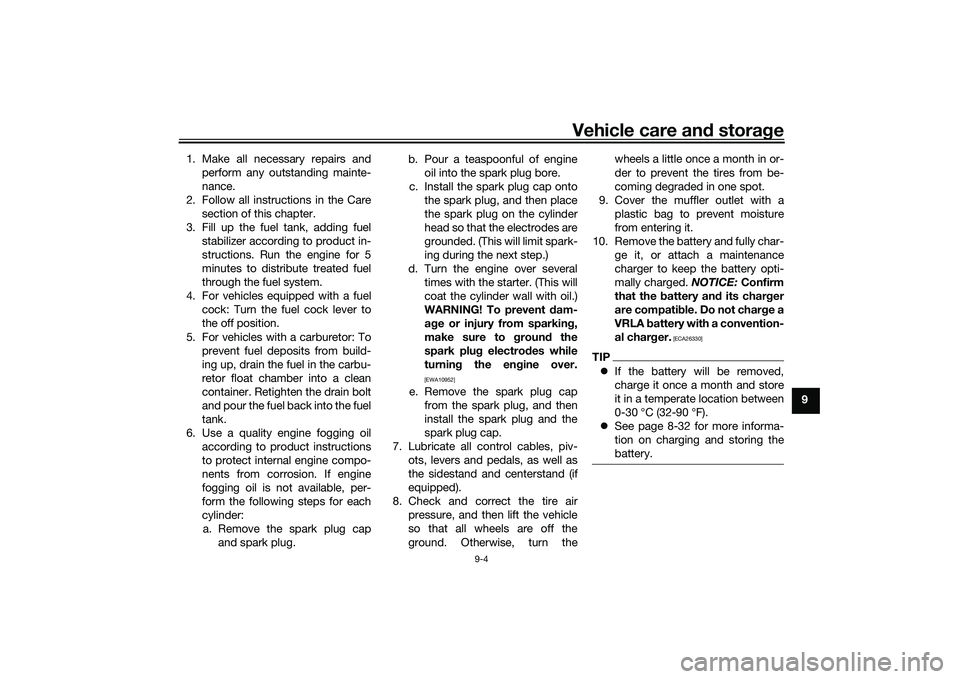
Vehicle care and stora ge
9-4
9
1. Make all necessary repairs and
perform any outstanding mainte-
nance.
2. Follow all instructions in the Care section of this chapter.
3. Fill up the fuel tank, adding fuel stabilizer according to product in-
structions. Run the engine for 5
minutes to distribute treated fuel
through the fuel system.
4. For vehicles equipped with a fuel cock: Turn the fuel cock lever to
the off position.
5. For vehicles with a carburetor: To prevent fuel deposits from build-
ing up, drain the fuel in the carbu-
retor float chamber into a clean
container. Retighten the drain bolt
and pour the fuel back into the fuel
tank.
6. Use a quality engine fogging oil according to product instructions
to protect internal engine compo-
nents from corrosion. If engine
fogging oil is not available, per-
form the following steps for each
cylinder:a. Remove the spark plug cap and spark plug. b. Pour a teaspoonful of engine
oil into the spark plug bore.
c. Install the spark plug cap onto the spark plug, and then place
the spark plug on the cylinder
head so that the electrodes are
grounded. (This will limit spark-
ing during the next step.)
d. Turn the engine over several times with the starter. (This will
coat the cylinder wall with oil.)
WARNING! To prevent dam-
a g e or injury from sparkin g,
make sure to groun d the
spark plu g electro des while
turnin g the en gine over.
[EWA10952]
e. Remove the spark plug cap
from the spark plug, and then
install the spark plug and the
spark plug cap.
7. Lubricate all control cables, piv- ots, levers and pedals, as well as
the sidestand and centerstand (if
equipped).
8. Check and correct the tire air pressure, and then lift the vehicle
so that all wheels are off the
ground. Otherwise, turn the wheels a little once a month in or-
der to prevent the tires from be-
coming degraded in one spot.
9. Cover the muffler outlet with a plastic bag to prevent moisture
from entering it.
10. Remove the battery and fully char- ge it, or attach a maintenance
charger to keep the battery opti-
mally charged. NOTICE: Confirm
that the battery an d its char ger
are compati ble. Do not char ge a
VRLA battery with a convention-
al char ger.
[ECA26330]
TIP If the battery will be removed,
charge it once a month and store
it in a temperate location between
0-30 °C (32-90 °F).
See page 8-32 for more informa-
tion on charging and storing the
battery.
UBX9E0E0.book Page 4 Monday, January 20, 2020 10:54 AM
Page 106 of 114
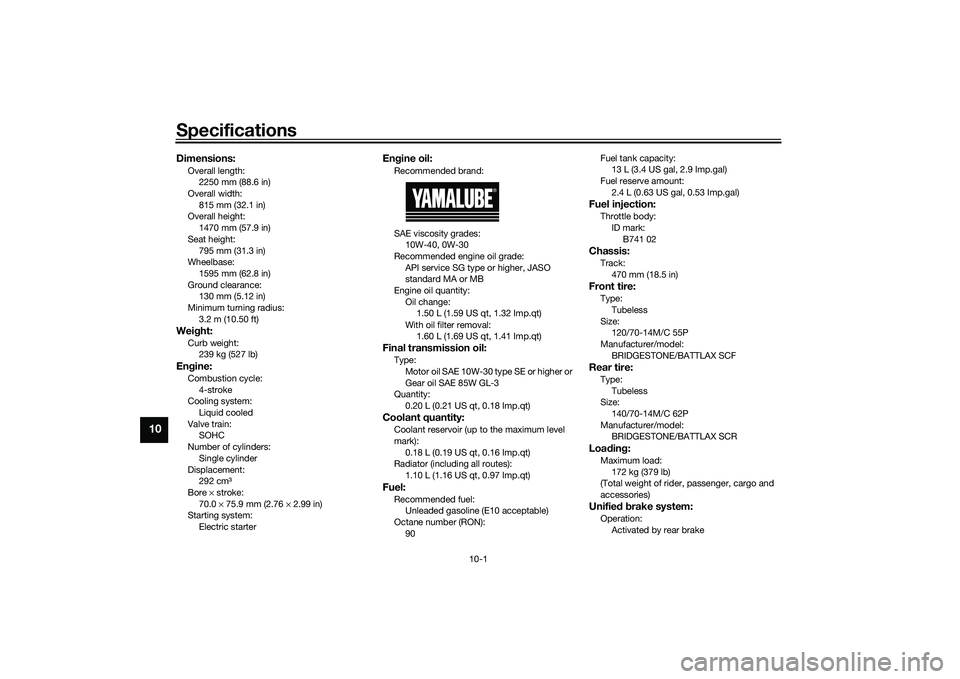
Specifications
10-1
10
Dimensions:Overall length:2250 mm (88.6 in)
Overall width:
815 mm (32.1 in)
Overall height: 1470 mm (57.9 in)
Seat height: 795 mm (31.3 in)
Wheelbase:
1595 mm (62.8 in)
Ground clearance: 130 mm (5.12 in)
Minimum turning radius: 3.2 m (10.50 ft)Wei ght:Curb weight:
239 kg (527 lb)Engine:Combustion cycle:
4-stroke
Cooling system: Liquid cooled
Valve train: SOHC
Number of cylinders:
Single cylinder
Displacement: 292 cm³
Bore × stroke:
70.0 × 75.9 mm (2.76 × 2.99 in)
Starting system:
Electric starter
Engine oil:Recommended brand:
SAE viscosity grades:
10W-40, 0W-30
Recommended engine oil grade: API service SG type or higher, JASO
standard MA or MB
Engine oil quantity: Oil change: 1.50 L (1.59 US qt, 1.32 Imp.qt)
With oil filter removal: 1.60 L (1.69 US qt, 1.41 Imp.qt)Final transmission oil:Type:Motor oil SAE 10W-30 type SE or higher or
Gear oil SAE 85W GL-3
Quantity: 0.20 L (0.21 US qt, 0.18 Imp.qt)Coolant quantity:Coolant reservoir (up to the maximum level
mark):0.18 L (0.19 US qt, 0.16 Imp.qt)
Radiator (including all routes):
1.10 L (1.16 US qt, 0.97 Imp.qt)Fuel:Recommended fuel:Unleaded gasoline (E10 acceptable)
Octane number (RON):
90 Fuel tank capacity:
13 L (3.4 US gal, 2.9 Imp.gal)
Fuel reserve amount: 2.4 L (0.63 US gal, 0.53 Imp.gal)
Fuel injection:Throttle body:ID mark:
B741 02Chassis:Track:470 mm (18.5 in)Front tire:Type:Tubeless
Size: 120/70-14M/C 55P
Manufacturer/model:
BRIDGESTONE/BATTLAX SCFRear tire:Type:Tubeless
Size:
140/70-14M/C 62P
Manufacturer/model: BRIDGESTONE/BATTLAX SCRLoa din g:Maximum load:
172 kg (379 lb)
(Total weight of rider, passenger, cargo and
accessories)Unifie d b rake system:Operation:
Activated by rear brake
UBX9E0E0.book Page 1 Monday, January 20, 2020 10:54 AM
Page 112 of 114
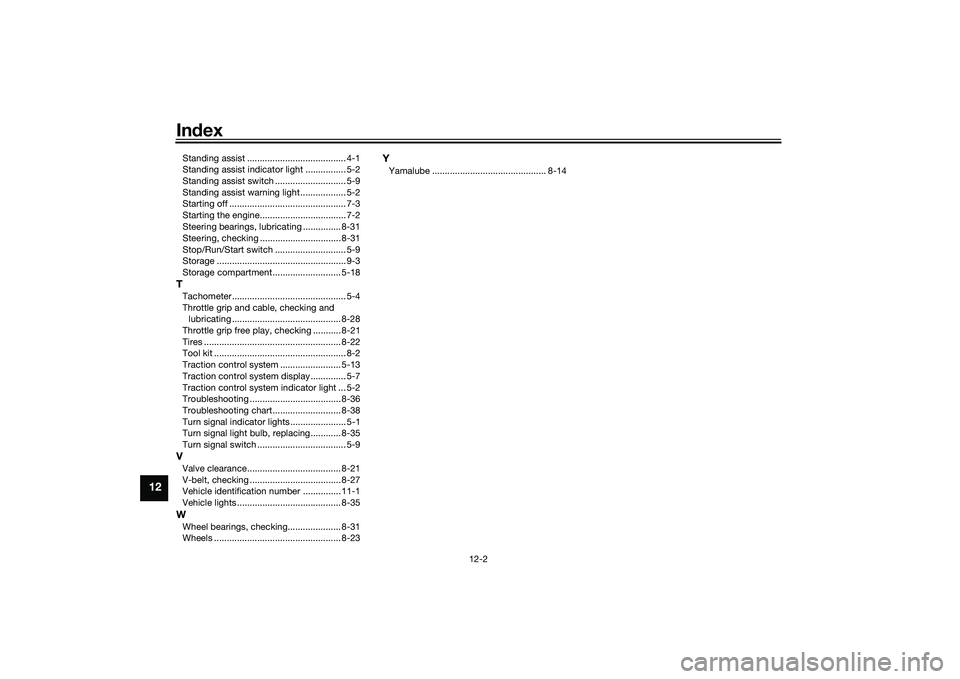
Index
12-2
12
Standing assist ....................................... 4-1
Standing assist indicator light ................ 5-2
Standing assist switch ............................ 5-9
Standing assist warning light .................. 5-2
Starting off .............................................. 7-3
Starting the engine.................................. 7-2
Steering bearings, lubricating ............... 8-31
Steering, checking ................................ 8-31
Stop/Run/Start switch ............................ 5-9
Storage ................................................... 9-3
Storage compartment ........................... 5-18TTachometer ............................................. 5-4
Throttle grip and cable, checking and
lubricating ........................................... 8-28
Throttle grip free play, checking ........... 8-21
Tires ...................................................... 8-22
Tool kit .................................................... 8-2
Traction control system ........................ 5-13
Traction control system display .............. 5-7
Traction control system indicator light ... 5-2
Troubleshooting .................................... 8-36
Troubleshooting chart........................... 8-38
Turn signal indicator lights ...................... 5-1
Turn signal light bulb, replacing............ 8-35
Turn signal switch ................................... 5-9VValve clearance..................................... 8-21
V-belt, checking .................................... 8-27
Vehicle identification number ............... 11-1
Vehicle lights ......................................... 8-35WWheel bearings, checking..................... 8-31
Wheels .................................................. 8-23
YYamalube ............................................. 8-14
UBX9E0E0.book Page 2 Monday, January 20, 2020 10:54 AM